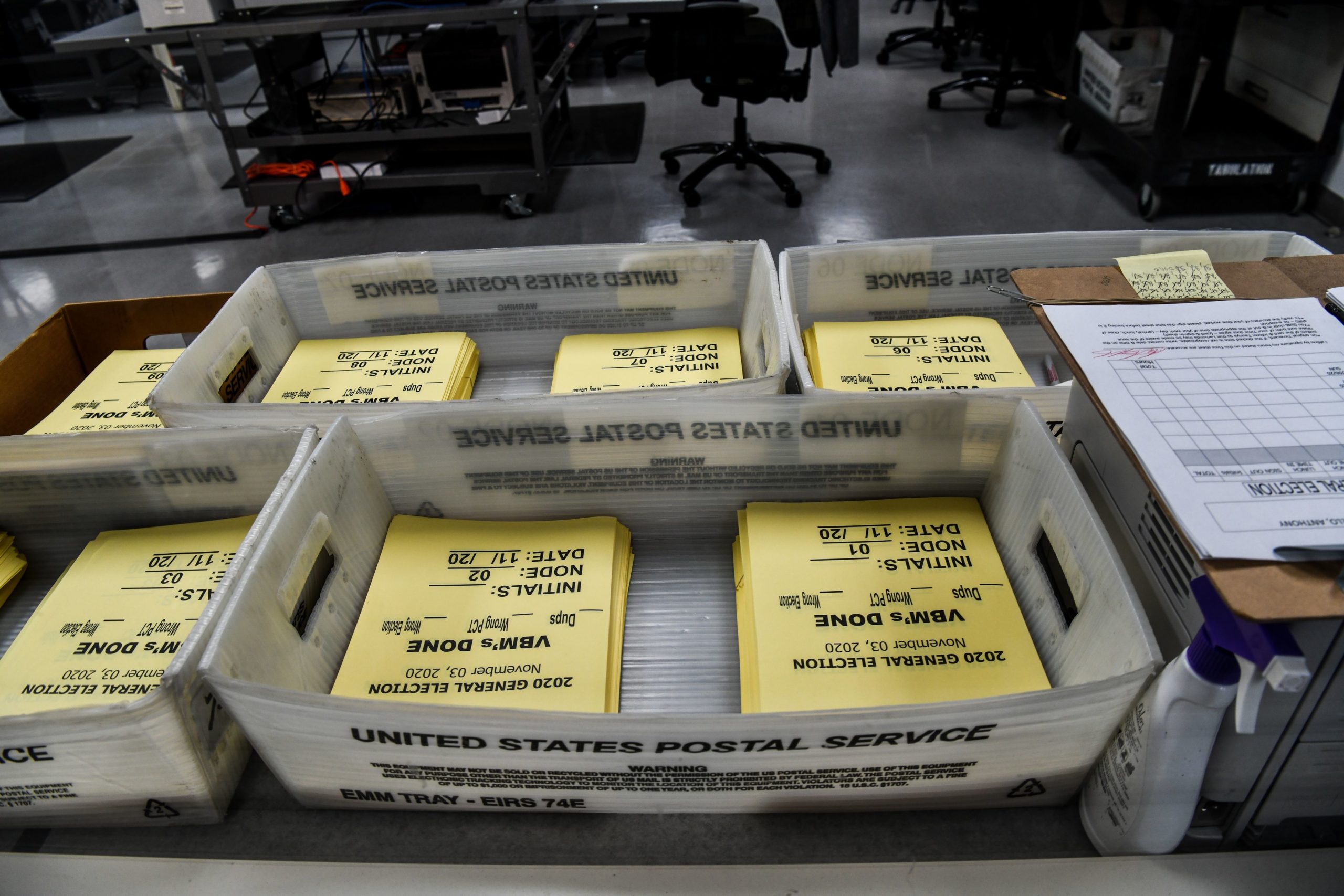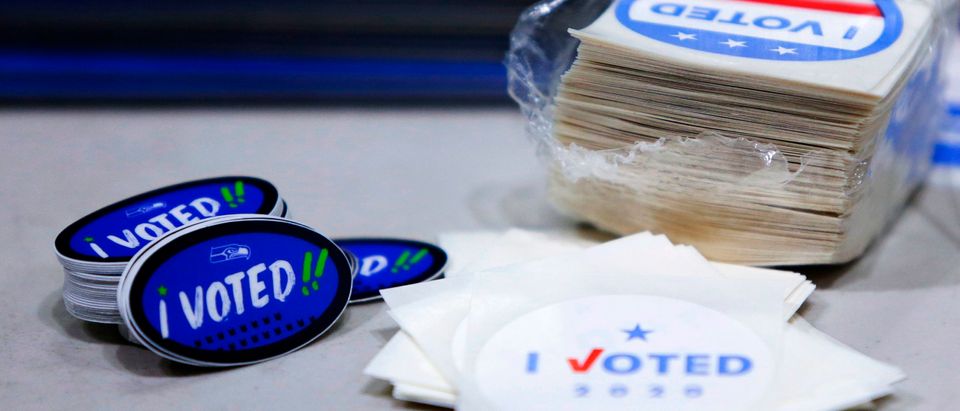- States have implemented protections against mail-in ballot fraud including bar codes, signature verification and post-election audits, according to The Brennan Center For Justice.
- “Mail ballots require different processing procedures and because of the increase in mail ballots this year, this is taking more time,” Verified Voting, a non-partisan organization that promotes election security, said in a Nov. 4 statement.
- While several media organizations including the Associated Press and Fox News declared former Vice President Joe Biden the presidential election winner on Saturday, President Donald Trump has not conceded the election.
President Donald Trump’s campaign has filed legal challenges over election results in several states and has alleged mail-in ballot fraud, but states’ vote verification process has been designed to prevent fraud, according to multiple election groups.
States have implemented protections against mail-in ballot fraud including bar codes, signature verification and post-election audits, according to The Brennan Center For Justice. While several media organizations including the Associated Press and Fox News declared former Vice President Joe Biden the election winner on Saturday, President Donald Trump has yet to concede the election. His campaign has filed lawsuits in Pennsylvania, Georgia, Michigan and Nevada.
“We must give election officials the time they need to count and verify every ballot — doing so is a sign that our democracy is working,” Verified Voting, a non-partisan organization that promotes election security, said in a Nov. 4 statement.
“Mail ballots require different processing procedures (such as checking the ballot envelopes for eligibility, signature checking, sorting and preparing them to be scanned) and because of the increase in mail ballots this year, this is taking more time,” the statement continued. (RELATED: ‘Come Back To Haunt’: Pennsylvania Lawsuit Alleges 21,000 Dead People Still On Voter Rolls)

Election workers count ballots on Nov. 6 in Philadelphia, Pennsylvania. (Chris McGrath/Getty Images)
Most election jurisdictions have implemented bar codes on ballots to help officials track and verify the ballots, according to the Brennan Center. Bar codes are placed on ballot envelopes to help counties track ballot processing and prevent duplicate votes from one voter.
Ballot tabulation machines use a “master bar code,” which is located on the ballot itself, not the envelope, according to a 2019 National Association of Secretaries of State (NASS) report. The machine is able to identify which candidate the voter selected using the bar code.
“Studies indicate that even the best-trained data entry operator will make an error approximately every 300 key strokes,” the NASS report said. “In comparison, even the simplest barcode has an error rate of less than .00025 percent.”
Signature verification is another measure used by states to secure and verify ballots, according to the Brookings Institution. It consists of elections officials comparing the slant, letter size, letter shape, pen lifts and fluidity of a signature on a mail-in ballot with that of the voter’s signature on file.
The Brennan Center has touted signatures as an important security measure to prevent voter fraud.

Paperwork for sorting ballots is seen during the vote-by-mail ballot scanning process at the election department in Miami, Florida on Nov. 3. (Chandan Khanna/AFP via Getty Images)
“We actually compare every single signature of every single ballot that comes in and we compare it and make sure that it matches the one on their voter registration record,” said Kim Wyman, Washington Secretary of State, CBS affiliate KEYE-TV.
However, some groups including the American Civil Liberties Union, have criticized the ballot signature requirement saying it negatively “affects voters already at the margins.” (RELATED: Late Ballots, Mismatched Signatures, Drop Boxes — Here’s How Hundreds Of Lawsuits Could Affect The Election’s Outcome)
On Oct. 27, U.S. District Judge Richard Gergel issued an order Tuesday halting South Carolina counties from rejecting absentee ballots due to missing or mismatching signatures, according to The State.
Most states implement signature verification and allow voters to correct or “cure” ballots when the signature doesn’t match the one on file, according to Ballotpedia. Some states, though, including Pennsylvania, Wisconsin and North Carolina do not use signature verification.
National Vote at Home Institute chief executive officer Amber McReynolds told The New York Times that signature matching is a good way to ensure “security, transparency and accessibility” for voters.

Victoria Ferrer, County Judge, working with the Miami-Dade County Canvassing Board uses a magnifying glass to inspect a Vote-by-Mail ballot for a valid signature at the Miami-Dade County Elections Department on Nov. 3. (Joe Raedle/Getty Images)
State officials also conduct audits to ensure that misconduct or irregularities didn’t occur during the counting process, according to the Brennan Center. Officials will review a statistically significant sample of ballots to confirm they were tabulated correctly.
Mail-in votes are easy to verify through an audit since they are on paper ballots, according to Brennan Center. The Brennan Center advocates for voting methods that produce a paper record so that results can be easily audited by state officials.
States vary in the equipment and method of voting that they utilize, according to Verified Voting. While most jurisdictions have a voting system that produces a paper record that can be audited, counties in New Jersey, Indiana, Kentucky, Tennessee, Mississippi, Louisiana, Kansas and Texas do not have such systems.
“Elections belong to the public,” a National Election Defense Coalition report on the importance of audits said. “The public must be allowed to observe, verify, and point out procedural problems in all phases of the audit without interfering with the process.” (RELATED: David Bossie, The Trump Official Overseeing Campaign’s Election Legal Battles, Reportedly Tests Positive For Coronavirus)
A common type of post-election audit is a process of officials looking at a fixed percentage of voting machines and voting districts and then comparing the voting systems’ results with the paper record, according to the National Conference of State Legislatures (NCSL). Thirty-four states and Washington D.C. conduct this type of audit regardless of the outcome of the election.
For example, in West Virginia, officials conduct post-election audits by randomly selecting three precincts and comparing automated ballot counts to manual ballot counts, according to the NCSL. If there is a more than 1% difference between manual and automated counts, the public is notified and all paper ballots are counted by hand.
All content created by the Daily Caller News Foundation, an independent and nonpartisan newswire service, is available without charge to any legitimate news publisher that can provide a large audience. All republished articles must include our logo, our reporter’s byline and their DCNF affiliation. For any questions about our guidelines or partnering with us, please contact licensing@dailycallernewsfoundation.org.


